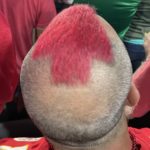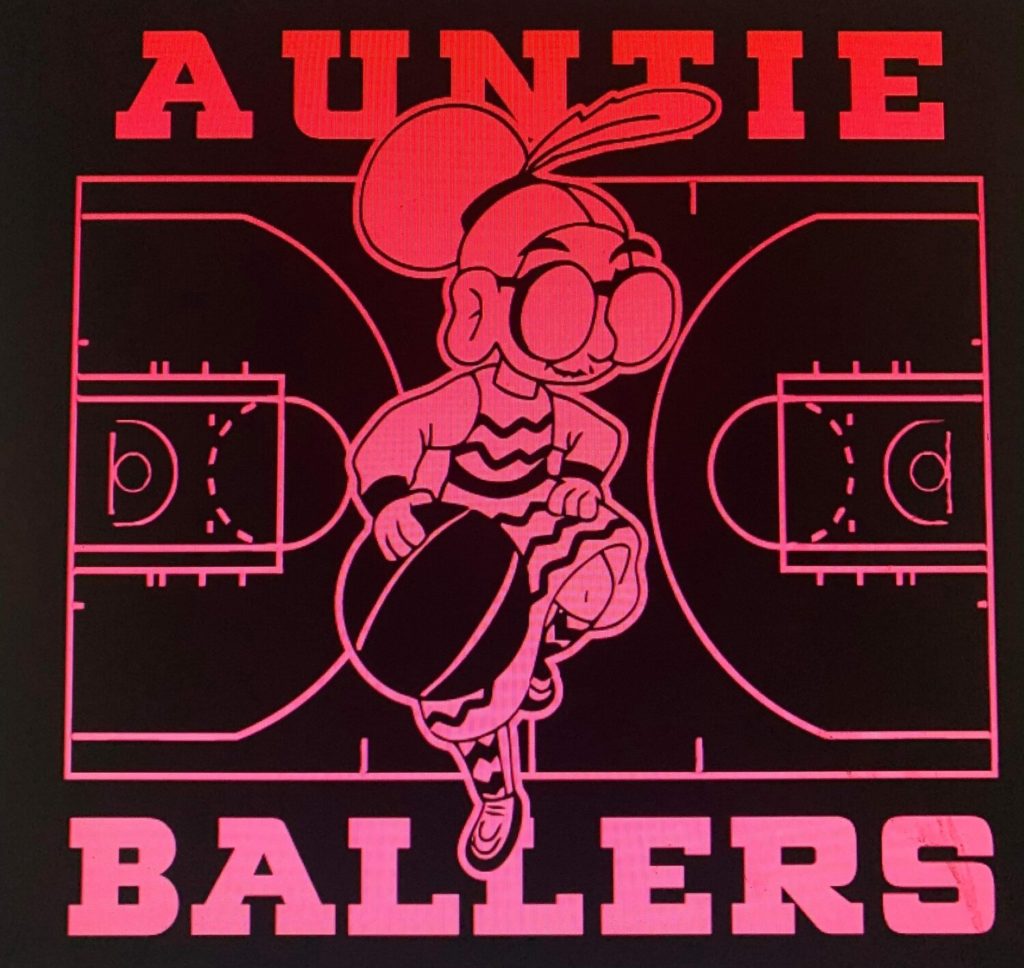
Basketball holds a special place in Indian country. In fact, Natives “discovered” basketball and now claim it as their own. True. It’s ours. If you are skeptical of this “discovery” assertion, you should have been in Norman, Oklahoma this weekend for the Annual “Oklahoma’s Best” All Indian State Tournament. Or check out any state championship tournament where there’s an Indian team from an Indian school. It’s indescribable next level.
This weekend’s tournament was a different kind of March Madness. More belly laughs. More older athletes who “still got it.” More families. More art and design for sale. Even some old-school Oklahoma women’s 6-on-6 ball. I was one of the “Auntie Ballers” – the team that won the “old ladies’ bracket.”
In a large metal building, several hundred people, from countless Indigenous Nations, burned up four basketball courts for a weekend of nonstop hoops, including a 15 hour Saturday. Wado/Mvto to Roland Roberts for organizing this great tournament and also to all the staff, refs, and vendors. There’s not too many sporting events where one can acquire hoodies featuring Baby Yoda in tribal regalia. Hot ticket item. Yes, Baby Yoda belongs to Indians, too. It’s a thing. I don’t make the rules.
Tribal governments have done an amazing job in deploying the vaccine. After reaching critical mass in their own communities, many tribes are now offering vaccines to the general public, much faster than other communities are able to do it. I’d bet money that this basketball tournament had more vaccinated people (per capita) than any other large event in the United States this past weekend. This place felt safe, for so many reasons. After this past year, it was exactly the tonic the Auntie Ballers (and others) really needed.

Basketball and Boarding Schools
Technically, James Naismith invented basketball, wrote the first official rules in 1891 and kicked off the University of Kansas (KU) basketball program in 1898. Basketball gained steam quickly, debuting as a demonstration sport at the 1904 Olympics in St. Louis.
Just south of the KU campus in Lawrence, Kansas stood an Indian boarding school then known as Haskell Institute where the game became very popular and remains so today. The modern-day successor is Haskell Indian Nations University, with an all-Native student body and a mostly Native faculty and staff. The photo above is the Haskell team from 1907.
Here’s a similar photo from a few years later at the United States Indian Industrial School in Carlisle, Pennsylvania. Carlisle was considered the flagship Indian boarding school. Carlisle operated from 1879 until 1918. Check out Jim Thorpe in the upper left in the photo below.
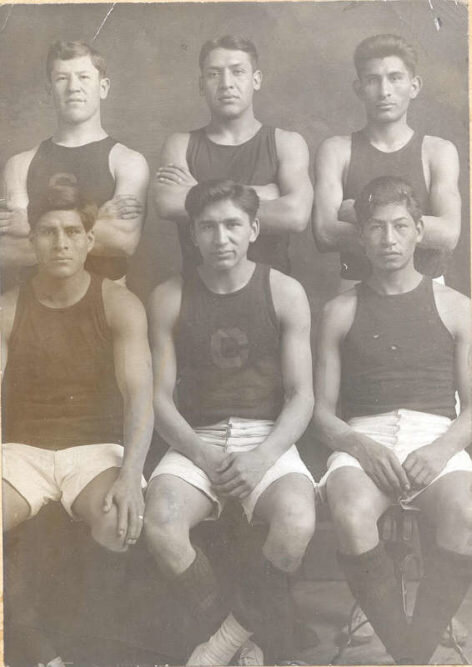
These basketball photos represent a relatively happy picture of the boarding school experience: recreation, play, friendly competition and the bonds of a team. Full stop there. If you don’t know the rest of this story, sit down. If you know it, read it again.
These boarding schools were part of the United States’ wholesale removal of Indians. First, kill them on the battle field when they wage “war” to protect their homelands from you. Second, with or without war, remove them from what’s left of their homelands and relocate them to small Indian reservations in a part of the country you don’t think you’ll ever need. But you will. Then, in the next generation, actually remove thousands of their children from their homes, from their families. For the Indian children you don’t take and send several states away, you can employee some of the same techniques, locally. In the public schools.
Attempted colonization is a steady process. It’s never been about an isolated “event.” Break up the land. Break up the families. Break their hearts. Break almost everything. If there’s to be any healing, that’s on the Indians themselves. Basketball became one way to heal. A way to momentarily escape.
Step One.
Physically take an Indian child from their parents, communities, Nations. Place that child in military-style industrial boarding school where they can be systematically and purposefully “assimilated” into the great American melting pot. Start like you do with enlisted troops and cut their hair. Something deeply important to them, becomes your initial exercise of dominance and control.
Step Two:
Now that you have physical possession of these kids as a captive audience, forbid them to engage in their own religions and cultures and beat them for speaking their language. Try to kill their stories. Their connections. Their memories. Keep telling those young ones that their Nations aren’t real Nations. That their institutions are not real institutions. That they and their families are inferior. Try to get to the point that they understand and internalize that erasing “the Indian” in them is part of “our” manifest destiny.
Step Three:
Make sure they physically dress, act and look like you to the greatest extent possible. Do this in such a persistent manner that you actually feel good about yourself. Tell yourself you are actually doing these kids a favor. “Kill the Indian and save the man.” If you do this well enough, someday your grandchildren will tell their grandchildren: “you don’t really look like Indians to me.” Because, what is an Indian? A cartoon. A sports mascot. Indian identities consciously and subconsciously redefined and remanufactured by non-Indians. And if you want to take their identity for your own use, hell take that, too. You can minimize their reality, their actual lived experiences, by telling them you are “part-Indian” too. Who cares if that’s a myth. Why question what your granny told you? And remember to tell the Indians when they should, and when they should not, be offended by something you do. Only you get to be the decider. Not them. Exhausting as it is.
Unspeakable things happened to the children in these places in the name of god and country. Sometimes the federal government ran these institutions and programs. Sometimes operation was delegated to religious organizations instead.
Children living out nightmares. Families mourning them. Nations left with only a fraction of their next generations.
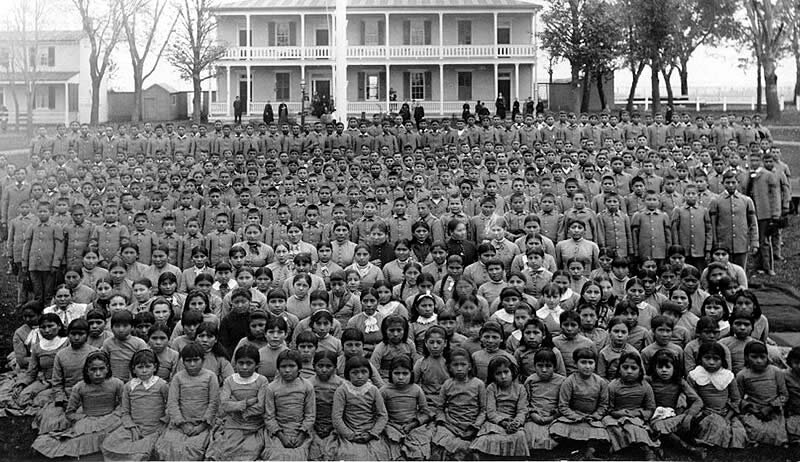
But . . . Basketball? Really?
The legacy of intergenerational trauma, including but hardly limited to boarding schools and forced adoptions, leaves deep bruises. You can see the impact everywhere you look in Indian country, if you know what you are looking at. And sometimes Native people and Native institutions do some unspeakable things to themselves and to other people too. Lay it all out there. Raw. Own all that too.
But you know what? Those boarding school kids and the others, just wouldn’t be erased. They refused to be conquered. They survived. Although some were lost, the rest of them did what their ancestors have been doing for a long time by now: they made the absolute best of really horrible situations. Actually laughed their way through much of it. They took the best of what they had been exposed to and tried to purge the rest. Compartmentalize.
What these kids took home, they adapted to their own style. Claimed it for their own purposes. It gets reinvented again, with each new generation.
Basketball. Survival. Both are team sports. Both are among god’s gifts to Indian country. The laughter. Identity. Kinship. That immediate connection. The fire in the belly. Indians totally “get” the Cinderella story. The underdog. Digging your way out. Leaving everything on the court. Being the clutch player. Cool as a cucumber, as you carry the outcome of the game, or what seems like the weight of the whole world, on your shoulders. I got this. And it just goes swish. In a world of things that cannot be controlled, give me the ball. I’ve got this. Block that shot. Not in my house. Therapy. And so many more stinkin’ metaphors.
And then there’s the very real part that is true on Indian reservations (and other parts of rural and urban America where poverty and struggle prevails): ANYONE can play basketball. It’s fully accessible and inclusive. Short. Tall. Skinny. Fat. Gay. Straight. Light. Dark. All you need is a ball and a hoop and some shoes. And you might be one of the lucky ones. Basketball could be your way out of a bad situation. Or your ticket to a higher education that will transform the lives of not just you, but your whole family and the next generation. Or you might just play by yourself, in the back of the house, for hours alone, until your fingers bleed, or until your mom makes you come inside.
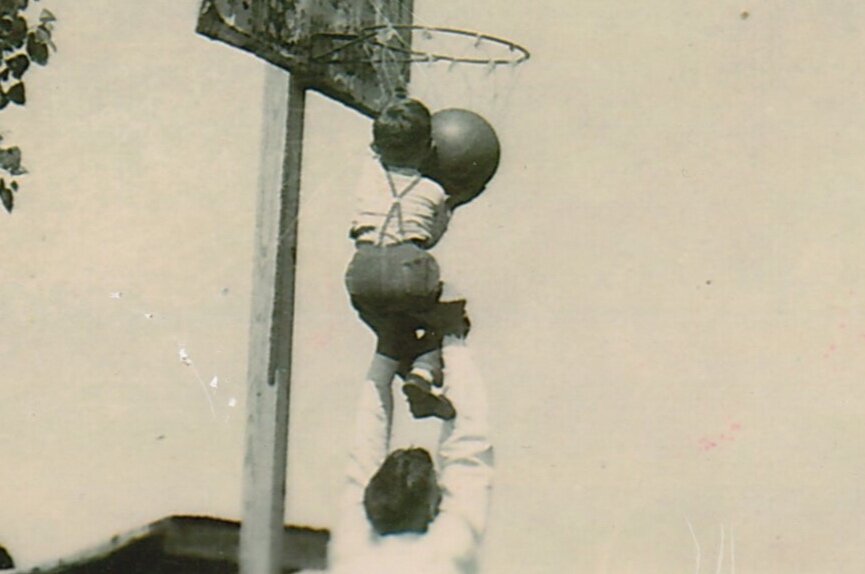
The Auntie Ballers
If you are lucky, you get to play on a team like we did this weekend. Maybe it’s been 25 years since your last “real” college or high school game. But then you find yourself on a team with some people you haven’t seen in a while, plus some folks you just met. And there is an immediate, unquestionable, and yes, almost freakish, bond. It’s as if the whole world stopped to allow you all to escape together. The sound of shoes squeaking on a wood floor. Leather balls bouncing. You may have just met this person five minutes ago, but you fully communicate with her with just a facial expression, and she knows EXACTLY what you mean and she responds accordingly. No words exchanged. These, are the Auntie Ballers.
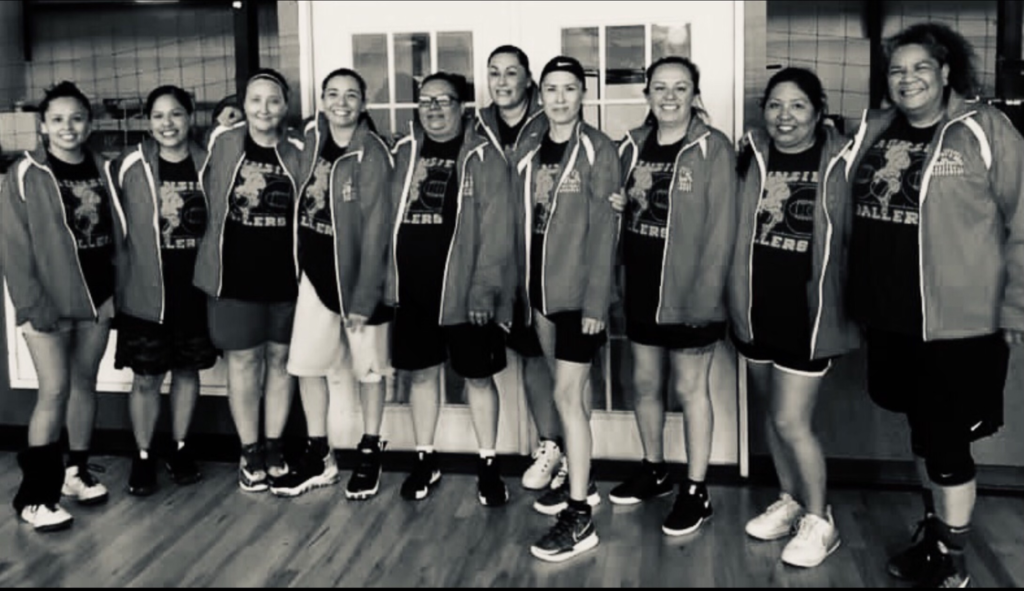
With special thanks to Michael Owaleon Sr. for the artwork of the cool logo of the lil’ Auntie hooping it up while wearing her ribbon skirt, we entered the women’s 30+ bracket thanks to our leader, Carla Feathers. Our team ranged from age 30-49. The two oldest of us graduated high school in 1990. A few of us actually played this divided court Oklahoma style 6-on-6 basketball back in junior high or high school.
Oklahoma schools eventually ended the half court stuff and switched to full court 5-on-5, which I think is all for the better. I always thought too many basketball scholarships were left on the dying vine at the guards’ end of the floor. Opportunities unrealized. Sad.
As it turns out, women CAN run up and down the basketball court for hours on end. Day after day. And their uterus won’t fall out. Or whatever. They can go on to be mothers, or aunties, or both, if they want.
Whatever they want to do in life is enhanced by, but never restricted by, the fact they played ball. But I have to admit, it was kinda cool to go back to this style of play for a weekend. And it was hilarious to see how totally foreign this game was to the youngsters.
Our games were very physical. When the sun came up on Monday, we had sore bodies and bruised arms, shins and one hurt chin. After battling our way through the consolation bracket after an early loss, we made it to the championship game and prevailed.
We all play to win. In whatever we do. We are the Aunties in our communities. Aunties have various responsibilities AND the freedom to sass. The freedom to call stuff out. Freedom to redefine ourselves as often as we want. Same goes for our communities. It’s our call. Reject or embrace a stereotype. We decide.
Our team was comprised of 11 amazing women who I admire and will hold dear. Yes, even the ones I met for the first time on Saturday. Tied by citizenship/membership/family/work to so many different tribes: Pawnee, Cheyenne, Arapaho, Ponca, Osage, Keetoowah, Potawatomi, Chickasaw, Choctaw, Dine, Wichita, Cherokee, Creek. Over the years, many on that team have been students, faculty, staff at Haskell, myself included.
We all made it home safely, back to our lives and our jobs as educators, contractors, health care professionals, administrators, directors, coaches, recreation specialists, business owners, filmmakers, authors, lawyers, builders. And we are athletes. Then and now. And basketball actually belongs to us.
Hearty congratulations to all the ballers on the other teams and in the other brackets. As you might expect, this tournament had the best team names ever:
Rez Dawgz, Unconquerable, Run & Gun, Yack’em, Savage Inc., UnderDogs, War Paint, Meskwaki Bucks, Sip’ Boys, Native Soldiers, MAB, Otoe Che, OK, Mississippi Choctaws, NTS, Southern Smoke, Cobra Kai, Indian City, VanCity, Free Agents, Lights Out, Malibu Warriors, Travelers, Elite Ballers, Flight, Native Kings, YHK, Bok Home, Rez Runners, Relentless, No Limit, Game On-MS, Da Tribe, Girls, Showtime, Lady Native Soldiers, Ballers, Tenacity, Moccasin Trail, Oklahoma Natives, N8ive Queenz, Lady Unconquerable, Lady Rebels, The ReDos, GOAT, Lady Indians, Free Agents, Run & Gun, Impa Chi, MTS, Just Lil Ol, MS Legends, Big Eagle Xpress, Descedents, Intertribal NDNz, Native Evolution, Okmulgee Warriors, Tribe, Old School, Killer Whales, War Party, Crazy Snake, Hostile Hoktes, Wild Ones, and Free Agents redux.
Leaving you all with good thoughts, hoop dreams, and a lil’ Indian Baby Yoda. (Send some money to Hustle Tribe for yours).
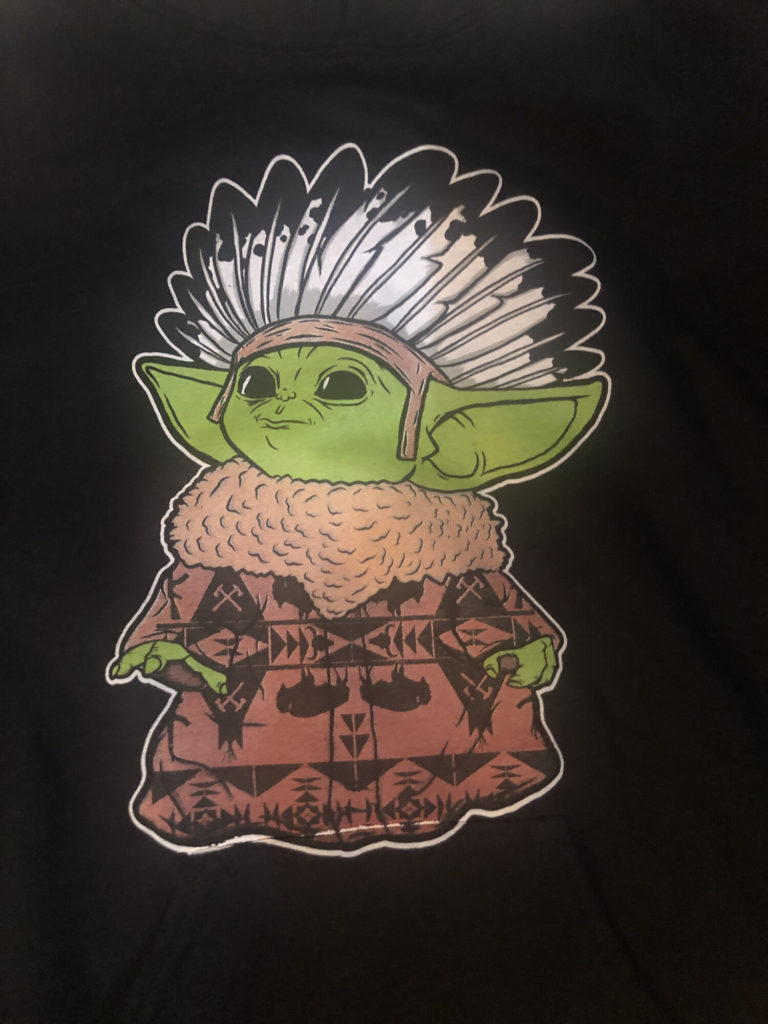
Also in "Discoveries"
Worth the Money: Three
This blog contains a series of posts entitled “Worth the Money.” For those of us who grew up without a bunch of money, we sometimes…
Can’t Eclipse Optimism
Yesterday was the big eclipse. I’ve been reading with great interest the various stories and responses to this event from tribal communities. I always remind…
High on the Hill
Earlier this month, Judge Sara Hill started her new job. She is a new federal district court judge. United States District Court for the Northern…
Happy Campers
Growing up, we weren’t the kind of people that went to summer camps. I learned about those “city-kids-off-in-the-woods-near-some-lake-for-three-weeks-and-get-your-first-kiss” kind of camps from 1980s coming of…




